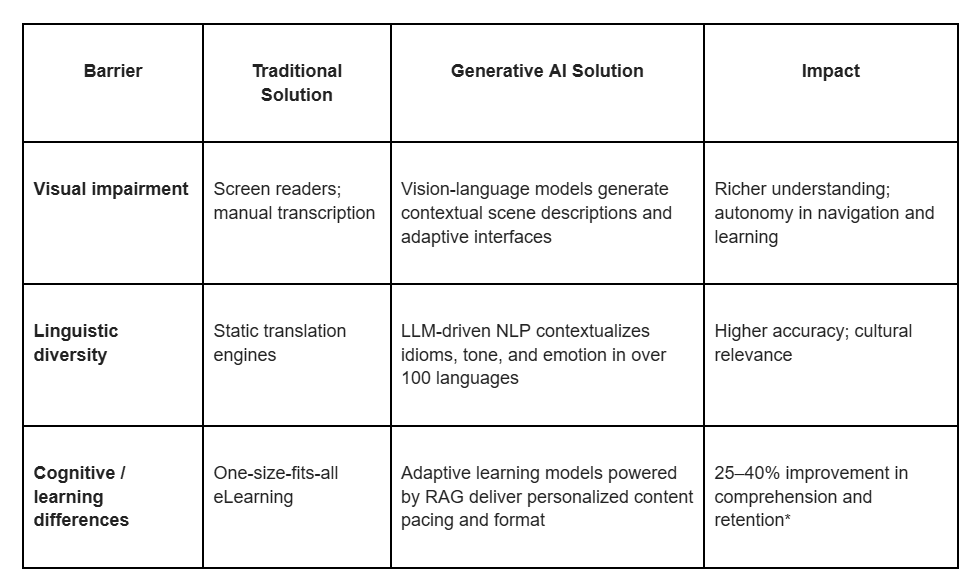November 20, 2025
10 min. reading time
The next frontier of accessibility
For decades, accessibility in the digital enterprise focused on compliance—ensuring screen readers, captions, and navigation aids met regulatory standards. But as large language models (LLMs) and generative AI (GenAI) evolve, a new paradigm is emerging: one where inclusion isn’t a retrofit, but an embedded capability.
Gartner predicts that by 2027, over 80% of enterprises will integrate generative AI into accessibility and personalization features within their digital ecosystems. This shift reframes accessibility as a driver of innovation rather than a checkbox for compliance.
The new question for leaders: How can generative AI systems not only adapt to human limitations—but actively amplify human potential?
The rise of adaptive, inclusive intelligence
Generative AI models—particularly LLMs and multimodal architectures—can now process text, speech, and images simultaneously. This fusion enables systems that learn context, intent, and emotion in real time, providing accessibility solutions that are fluid, not fixed.
Three foundational technologies are driving this change:
- Natural Language Processing (NLP): Powers real-time captioning, voice synthesis, and translation—giving users agency through language understanding and generation.
- Retrieval-Augmented Generation (RAG): Bridges LLM reasoning with trusted data sources, allowing adaptive learning systems to retrieve and generate accurate, personalized outputs.
- Generative Models: Transform static interfaces into interactive experiences, from visual description generation for the visually impaired to dynamic learning companions for neurodiverse users.
Together, these technologies shift accessibility from assistive to augmentative—moving beyond “helping” individuals to enabling equal participation in knowledge work and digital life.
Breaking barriers across three dimensions

* McKinsey Global Institute, 2024: “AI in Learning and Development—The Productivity Dividend.”
These capabilities don’t replace traditional accessibility tools—they amplify them, turning linear experiences into dynamic, conversational ecosystems.
Generative accessibility in practice
1. Conversational agents for inclusion
LLM-powered virtual assistants can now act as digital interpreters. They translate not just language but intent, recognizing idiomatic or partial speech patterns. For individuals with speech impairments, this enables fluid communication in customer service, education, and telehealth.
Kloud9 has observed enterprises deploying agentic AI systems that integrate NLP with domain-specific RAG pipelines. These models access verified data sources to ensure responses remain accurate, traceable, and inclusive—a key safeguard when accessibility overlaps with compliance (e.g., medical or legal contexts).
2. Multimodal co-pilots in the workplace
Generative models are redefining how employees with disabilities interact with digital systems. A visually impaired engineer can query a design file through a conversational interface (“Show me the last change in this CAD drawing”) and receive a detailed text or voice summary.
Through adaptive learning loops, the system fine-tunes explanations to the user’s style—whether auditory, textual, or symbolic—creating a personalized layer of understanding across enterprise platforms.
3. Agentic AI for learning and inclusion
Kloud9 partnered with a large enterprise to build an intelligent Agentic AI chatbot using Google’s Vertex and Gemini frameworks. Pre-trained on internal learning materials, HR policies, and enablement assets, the system integrated with ERP and HRMS platforms to deliver contextual answers and on-demand learning support.
By automating redundant queries and adapting responses to user intent and complexity, the organization achieved up to a 70% productivity improvement across HR and support functions—freeing teams to focus on higher-value strategic initiatives while improving learning access and employee experience.
Governance and ethical imperatives
Inclusion must be built on integrity. As GenAI expands into accessibility, enterprises must address three governance imperatives:
- Data sensitivity: Accessibility data (e.g., speech patterns, cognitive profiles) is deeply personal. RAG architectures should use secure vector stores and consent-based retrieval to protect privacy.
- Bias mitigation: LLMs can inadvertently reproduce biases from training data. Continuous fine-tuning using diverse datasets and human-in-the-loop evaluation helps ensure equitable responses.
- Explainability: Accessibility tools must be auditable. Generative outputs should provide transparent reasoning traces—particularly in regulated sectors like healthcare, education, and finance.
Kloud9 embeds these controls at the architectural level, ensuring agentic systems remain trustworthy, transparent, and traceable.
The economics of inclusion
Accessibility has always carried moral weight; now it carries measurable ROI. Forrester research shows that companies investing in inclusive design outperform peers by 1.6× in customer satisfaction and 2.2× in employee retention.
When AI removes friction—through adaptive interfaces, intelligent transcription, or multilingual collaboration—productivity lifts follow naturally. McKinsey estimates that enterprise adoption of generative AI in workplace accessibility could unlock $1.3 trillion in additional global productivity by 2030.
What was once a compliance cost is now a growth lever.
Looking ahead: AI that understands everyone
Generative AI represents a significant step forward for accessibility. The convergence of LLMs, RAG pipelines, and adaptive learning transforms what inclusion means in practice—from accommodation to empowerment.
As Kloud9’s enterprise clients highlight, when AI understands context, nuance, and diversity, it stops being assistive tech—it becomes equalizing tech. The next era of accessibility will not be measured by compliance checklists, but by how seamlessly digital systems listen, learn, and adapt to every human voice.
